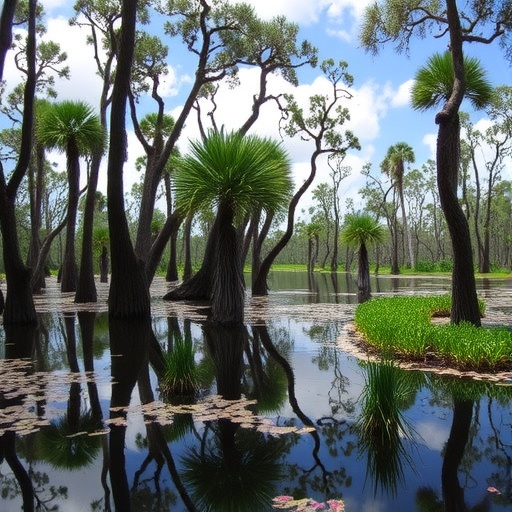For the first time ever, a comprehensive environmental study has unveiled the pervasive presence of per- and polyfluoroalkyl substances (PFAS) within the Miccosukee Indian Reservation in the heart of Florida’s Everglades. This groundbreaking research, conducted by Florida International University (FIU) in close collaboration with the Miccosukee Tribe of Indians of Florida, has detected a total of twelve different PFAS compounds contaminating surface waters across this ecologically sensitive region. Published in the journal Environmental Research, these findings herald an urgent call to better understand the ramifications of these so-called “forever chemicals” on water quality, ecosystem health, and restoration efforts ongoing in the Everglades.
PFAS are synthetic chemicals renowned for their resistance to heat, water, and stains, widely used in consumer products ranging from non-stick cookware to water-repellent fabrics and long-lasting cosmetics. However, their environmental persistence is alarming. These substances do not readily degrade, instead accumulating indefinitely in soil, water, wildlife, and even human bodies. The new measurements on the Miccosukee Reservation revealed surface water concentrations of PFAS ranging between 3.94 and 40.1 parts per trillion (ppt). When compared to levels detected in major canals of Miami, which exhibited concentrations between 30.1 and 153 ppt with 78% of samples exceeding safe screening standards, it becomes clear that the Everglades ecosystem is increasingly burdened by anthropogenic pollutants.
The implications of these findings are far from trivial. According to lead author Natalia Soares Quinete, an environmental chemist spearheading FIU’s PFAS research initiative, even low concentrations of these chemicals may pose significant risks to environmental and public health. The bioaccumulative nature of PFAS means that, over time, these substances can build up within organisms, potentially leading to toxic effects not immediately evident through snapshot environmental sampling. This is particularly concerning in the Everglades, a biodiversity hotspot and an irreplaceable water resource for South Florida.
Quinete’s research group is distinguished for its pioneering efforts in extensively mapping PFAS prevalence across South Florida’s hydrological systems. Past investigations by the team have identified PFAS contamination in drinking water sources, rainwater, local tributaries feeding into Biscayne Bay, as well as marine life such as oysters and economically important fish and lobster species. Their holistic approach emphasizes the interconnectedness of terrestrial, aquatic, and human health spheres, highlighting a pressing need to reassess environmental safety standards in light of these emergent contaminants.
The specific PFAS compounds identified on the Miccosukee Reservation include PFBA, PFOS, and PFOA. PFBA, a shorter-chain PFAS chemical, has been linked to adverse impacts on liver and thyroid function in laboratory studies. Meanwhile, PFOS and PFOA, which were historically industrial staples now phased out in many countries, have garnered attention due to their associations with cancer and other chronic diseases. Despite regulatory measures to reduce their production, these legacy compounds remain entrenched in the environment, underscoring the challenge posed by PFAS pollution.
This study’s genesis was itself a response to community concerns. The Miccosukee Tribe, cognizant of the integral relationship between their land, water, and cultural health, reached out directly to FIU researchers. They suspected that PFAS contamination might be compromising their water resources but lacked empirical data to confirm and quantify the threat. FIU’s engagement involved targeted water sampling at sites delineated by the tribal authorities, exemplifying a collaborative model where scientific inquiry supports indigenous environmental stewardship.
From the tribal perspective, clean and safe drinking water is paramount. Amy Castaneda, Water Resources Director for the Miccosukee Tribe, emphasized the constitutional commitment of the tribe to safeguard the health of its citizens alongside the integrity of its lands and waters. The scientific partnership with FIU enables identification of contamination risks, elucidation of contaminant sources, and development of effective mitigation strategies. Beyond tribal boundaries, this research bears significance for all residents of South Florida, human and ecological alike, as the Everglades is a shared environmental sanctuary.
One critical concern raised by the researchers is the current absence of PFAS considerations within Everglades restoration planning. Large-scale hydrological interventions aimed at restoring natural water flows and habitats fail to incorporate contaminant dynamics, thus risking unintended consequences for water quality and ecosystem resilience. Integrating contaminant monitoring and management into restoration frameworks is essential to holistic ecosystem recovery and protection.
Understanding the origins and pathways of PFAS pollution in this unique coastal environment remains an ongoing scientific challenge. Potential sources include urban runoff, industrial discharges, atmospheric deposition, and legacy contamination from prior land uses. Advanced chemical analyses combined with hydrological modeling will be crucial to mapping contaminant transport routes and identifying priority areas for intervention.
From a broader scientific vantage point, this study elaborates the multifaceted threat that PFAS compounds pose to environmental chemistry and toxicology. Their persistent character defies conventional pollutant paradigms, requiring innovative detection, tracking, and remediation methodologies. The escalating environmental footprint of PFAS calls for multidisciplinary research uniting analytical chemistry, ecology, public health, and policy action to chart effective responses.
In conclusion, the detection of multiple PFAS chemicals on the Miccosukee Indian Reservation marks a seminal moment in environmental science for South Florida. It spotlights a growing chemical threat within one of the nation’s most cherished and vulnerable ecosystems. Moving forward, comprehensive monitoring, community engagement, scientific innovation, and policy reform must converge to address PFAS contamination and safeguard the Everglades for generations to come. This study represents a critical foundational step in that enduring endeavor.
Subject of Research: Not applicable
Article Title: Per- and polyfluoroalkyl substances (PFAS) composition and distribution in surface water of the Miccosukee Indian Reservation, Everglades and tributaries in the coastal environment of Miami, Florida
News Publication Date: 1-Aug-2025
References:
DOI: 10.1016/j.envres.2025.121627 — Direct link
Image Credits: Anthony Sleiman / Florida International University
Keywords: Chemistry, Environmental sciences, Environmental toxicology, Pollution, Water pollution
Tags: ecological health of Florida Evergladesenvironmental impact of forever chemicalsenvironmental research on PFASEverglades water quality issueshealth risks of PFAS exposureimplications of PFAS on wildlife and human healthMiccosukee Tribe environmental studyPFAS contamination in Miccosukee Reservationrestoration efforts in Evergladessurface water PFAS concentrationssynthetic chemicals in consumer productswater pollution and PFAS





